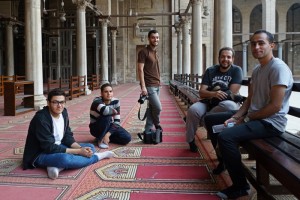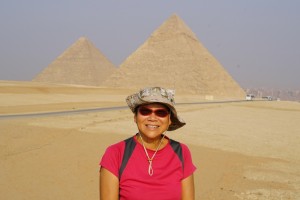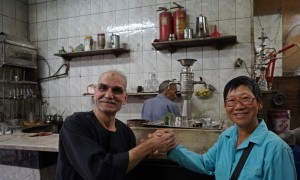Egypt: Cairo October 19 – 21, 2016
I visited Cairo and Luxor on my first visit to Egypt in 1979. On my second visit, I spent a couple of days in a resort in Hurguada, Red Sea and a day in Cairo after an organised tour to Morocco in the late 1990s. My two fleeting visits have only given me a taste of this ancient civilisation and I always want to return. I love travelling overland: a 26-day journey from Cairo to Khartoum with Dragoman is an ideal way to travel without hassles along the Nile River, the Red Sea and across the deserts.
The Nile River (The Nile)
The Nile, a north-flowing river in northeastern Africa, is generally regarded as the longest river in the world. The Nile has two major tributaries, the White Nile and Blue Nile. The former rises in the Great Lakes region of central Africa while the latter begins at Lake Tana in Ethiopia and flows into Sudan and the two rivers meet just north of the Sudanese capital of Khartoum. A 2006 expedition of the Nile using hi-tech mapping equipment indicates the Nile measures 6,710km long. Its water resources are shared by 11 countries and it is the primary water source of Egypt and Sudan.
Egypt
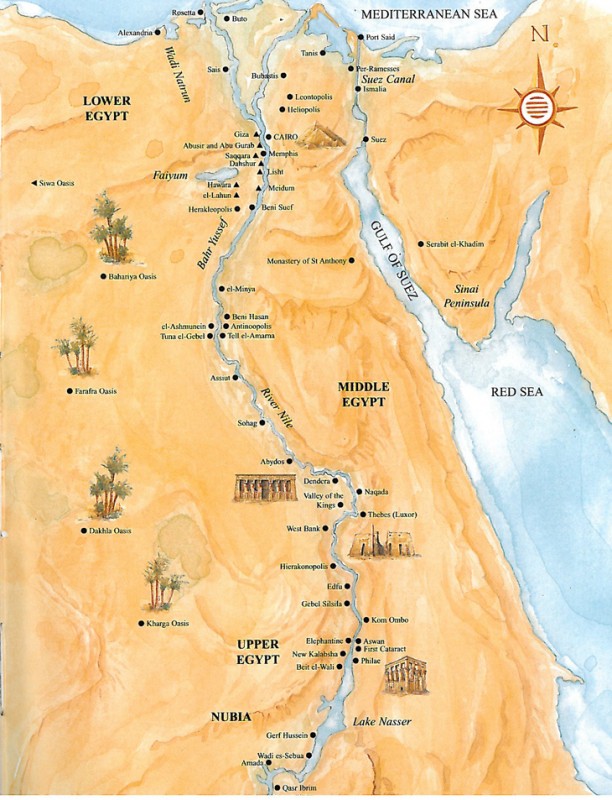 Egypt has one of the world’s most ancient civilisations. Stone tools found in Upper Egypt and in western desert prove the presence of hunter-gathering hominids over 250,000 years ago. Human settlement dates back to at least 40,000 BC with extensive irrigation systems developed by c.3300 BC. It is impossible to detail the history of Egypt but a brief outline with reference to the major periods as defined by ruling powers is useful.
Egypt has one of the world’s most ancient civilisations. Stone tools found in Upper Egypt and in western desert prove the presence of hunter-gathering hominids over 250,000 years ago. Human settlement dates back to at least 40,000 BC with extensive irrigation systems developed by c.3300 BC. It is impossible to detail the history of Egypt but a brief outline with reference to the major periods as defined by ruling powers is useful.
I. Prehistoric Egypt pre-3100 BC
II. Ancient Egypt (3100 -332 BC). Menes, founder of Memphis, unified the two lands (Upper and Lower Egypt) around 3150 BC. Over the next three millennia, Egypt was ruled by a series of dynasties.
- During the Old Kingdom period covering the I – IV Dynasties (c. 2700-2200 BC), the first Step Pyramid was built at Saqqara around 27th century BC. During the IV Dynasty, Cheops, Chephren and Mycerinus constructed the Pyramids of Giza.
- The Middle Kingdom (c. 2055-1650 BC) reached its peak during the reign of Amenemhat III c. 2040 BC and declined when the Hyksos took over much of Lower Egypt forcing the founder of the 18th Dynasty to relocate the capital from Memphis to Thebes.
- The New Kingdom period (c. 1550-1070 BC) with its capital in Thebes (present day Luxor) saw the rise of Egypt as an empire stretching as far south as Tombos in Nubia and included parts of the Levant in the east. The most well-known Pharaohs of this period are Hatshepsut, Thutmose III, Akhenaten and his wife Nefertiti, Tutankhamun and Ramesses II. The first historically attested expression of monotheism came in the reign of Atenism. During this period, Egypt was invaded and conquered by Libyans, Nubians (ruler of the 25th Dynasty) and Assyrians (ruler of the 27th Dynasty 525 – 402 BC)
III. Classical antiquity (332 BC – AD 641). Alexander the Great (356-323 BC) spent six months in 332 BC in Egypt as part of his on-going campaign against the Persian Empire of Darius III. He was regarded as liberator and pronounced son of Amun at the Oracle of Siwa Oasis in the Libyan desert. He founded the city of Alexandria. After his sudden death in Babylon in 323 BC, his general Ptolemy Soter established himself as the new ruler of Egypt. This Greek Ptolemaic Kingdom ruled Egypt until 30 BC when it fell under Cleopatra to the Roman Empire and became a Roman and later Byzantine province. During the 1st century, Christianity was brought to Egypt by Saint Mark the Evangelist. New Testament was translated into Egyptian and after the Council of Chalcedon in AD 451, a distinct Egyptian Coptic Church was firmly established.
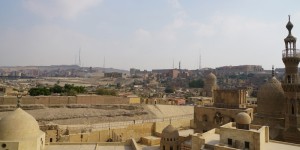 IV. Middle Ages AD 641- 1517. Egypt was invaded and conquered by Muslim Arabs beginning 641 who brought with them Sunni Islam. Muslim rulers nominated by the Caliphate remained in control of Egypt for the next six centuries: the Arabs 641 – 969; Fatimid 969 – 1171; Ayyubid 1171-1250 and Mamluk 1250-1517). Blending with indigenous beliefs and practices, Egyptians founded various Sufi orders.
IV. Middle Ages AD 641- 1517. Egypt was invaded and conquered by Muslim Arabs beginning 641 who brought with them Sunni Islam. Muslim rulers nominated by the Caliphate remained in control of Egypt for the next six centuries: the Arabs 641 – 969; Fatimid 969 – 1171; Ayyubid 1171-1250 and Mamluk 1250-1517). Blending with indigenous beliefs and practices, Egyptians founded various Sufi orders.
V. Early Modern (AD 1517-1953). Over these four centuries, the country was again ruled by the Ottoman from 1517 to 1867, became a Khedivate from 1867 to1914 and a Kingdom of Egypt from 1922 to 1953. It was under French occupation from 1798 to 1801 and became a British Protectorate from 1882 to 1953.
The most influential figure during this period is Muhammad Ali (1769-1849), an Ottoman Albanian commander, who rose to power in 1805 and later self-declared Khedive of Egypt and Sudan. He is often regarded as the founder of modern Egypt because of reforms in the military, economic and cultural spheres he instituted. The dynasty he established ruled Egypt and Sudan until the Egyptian Revolution of 1952.The Suez Canal, built in partnership with the French, was completed in 1869. But in 1875, Ali’s grandson Ismail was forced to sell Egypt’s share in the canal to the British government.
VI. Modern Republic of Egypt, founded in 1953 following a revolution led by Gamal Abdel Nasser has been marred by political instability, civil unrest, dictatorship, coup d’etat, revolutions, wars, terrorist attacks and numerous crises. The nationalisation of the Suez Canal and complete withdrawal of British forces in 1956 marked the first time in 2300 years that Egypt was both fully independent and ruled by native Egyptians. The Six Day War in 1967 with Israel is a hard blow to its pride and confidence.
The country has had many strong-man presidents including Muhammad Naguib who was Egypt’s First president (June 1953 – November 1954), Nassar (from Feb 1958 to September 1970 when he died in office), Anwar Sadat (from 1970 to October 1981 when he was assassinated) and Hosni Mubarak (from 1981 to the Egyptian revolution in February 2011). Widespread protests in February 2011 led to Mubarak’s resignation but the country remains in turmoil. President Mohamed Morsi was elected and removed by the military in July 2013. President Abdel Fattah el-Sis elected in June 2014, has tried to institute much needed social and economic reforms. The country has sadly been havocked by local terrorist groups that challenge the authority, attack foreign tourists and Egyptian Christians.
Egypt Today
Egypt, with an area of 1,101,450 km² and an estimated population of over 90 million, is the most populous country in the Middle East and third-most populous in Africa. 95% of the population live along the banks of the Nile, in the delta and along the Suez Canal. The vast majority (99.6%) are ethnic Egyptians who are native speakers of modern Egyptian Arabia. Major ethnic minority groups include the Nubians in Upper Egypt and the Berbers in the desert areas. 90% of the population is Muslim and 10% Christian.
The economy has switched from a highly centralised centralised planned economy under President Nasser to a more market-oriented one since 1990s. The country’s GDP (nominal) and PPP in 2015 were $330.765 million and $1.047 trillion respectively with an estimated GDP per capita of $3,740 (nominal) and $11,850 (PPP) (Source: IMF). The World Bank estimates 26% of the population live below the poverty line i.e. $1.9 a day (2015). In November 2016, the government decided to float the Egyptian pound: the official exchange rate moved from E₤8.8 for US$1 on October 19 at Cairo airport to E₤16 in a bank in Aswan on November 5 (but the black market rates had been between E₤10-16). The economic growth forecast is around 5.2% annually in 2017-21 (Source: EIU)
Egypt with its rich history and culture is one of the top tourist destinations. It boasts seven World Heritage Sites (six cultural sites: Abu Mena, Ancient Thebes and its Necropolis, Historic Cairo, Memphis and its Necropolis, Nubian from Abu Simbel to Philae and Saint Catherine area; and one natural site at Wadi Al-Hitan). Tourism is one of the leading sources of income contributing to about 10% of GDP. Unfortunately, political instability and terrorist attacks on tourists have hampered tourism growth: the number of international tourists dropped from the record number of 14.7 in 2010 million to about 10 million in 2015.
October 19 Wednesday Rome, Italy – Cairo, Egypt
My 3-hour flight to Cairo scheduled for 2pm was delayed for half an hour. No problem! But I had a horrible flight as I sat next to a lady whose youngest son (probably about five) is hyper-active. Her two elder children sitting nearby are well-behaved and quiet. The lady and her husband incited their unruly boy by playing with him: he screamed and stood on the seat next to mine. As I had no ear plug, I had to put my hands over my ears. I should have asked the flight attendant to find me another seat. Anyway, the parents did not apologise. I can see this boy if under undesirable influence, may become a trouble maker without self-control or judgement of right and wrong. Anyway, I watched a beautiful sunset before landing.
Cairo
When Muslim conquered Egypt for Islam in AD 641, they sited the city north of the Coptic Babylon. Cairo, founded in the 10th century, became the new centre of the Islamic world and reached its golden age in the 14th century. Historic Cairo, inscribed on the World Heritage List since 1979 in recognition of its “absolutely unquestionable historical, archaeological and urban importance”, encompasses the historic centre on the eastern bank of the Nile which includes no less than 600 classified monuments dating from the 7th to 20th centuries. Among them are Islamic Cairo, Coptic Cairo and its many old churches and ruins of Roman fortifications.
Cairo, the capital of Egypt and the world’s centre of Arabic culture, music and art, is a sprawling brown and dusty city with a population of over 20 million. As I had only two days before joining the Dragoman tour, I decided to visit the Coptic and Islamic areas in Old Cairo. I booked three extra nights at the King Hotel (located on the west side of River Nile and close to the metro station Dokki) where the Dragoman group would stay on October 22. An Italian businessman recommended me to take a limo instead of taking a taxi. I followed his advice and paid $15 for a limo with an English speaking driver.
Owing to bad traffic jam, the short journey to downtown Cairo took 90 minutes instead of 30-40 minutes. I can see visible changes with new highways and developments on my way to the hotel. I was hungry. As soon as I dropped my suitcase, I went out for street food. The grilled chicken, kebab, pizza and crepes all looked delicious: I bought a crepe with beef for E₤15. Back in my room, I was surprised to find the CNN channel and decided to get up at 3am to watch the third and final debate of the US Presidential election.
October 20 Thursday: Coptic Cairo
I was clued to the TV from 3 to 5am. The debate between Donald Trump and Hillary Clinton was as expected a rehearsed performance. But Trump’s manner, remarks on Clinton as ‘a nasty woman’ and refusal to accept the election result showed once again who he is and his mind set. I am horrified by his comments and simplistic views on complex issues and international politics (I was shocked to find him President-elect on December 8. Oh, my God!). I did not get up till 9:30am and set off an hour later. I took the metro to Mar Giris (E₤1).
Coptic Cairo encompassing the Babylon Fortress, the Coptic Museum, the Hanging Church, the Greek Church of St George and other Coptic churches and historical sites, was a stronghold for Christianity in Egypt until the Islamic era. The history of the Coptic Church in Egypt is basically the history of Christianity in Egypt. It is believed in Christian tradition that the Holy Family visited this area and stayed at the site of Saints Sergius and Bacchus Church (Abu Serga). Historically it was Saint Mark the Evangelist who founded the church: he preached and suffered martyrdom in Alexandria in AD 68. His body was buried in the chapel at Beucalis. In 828 AD, the remains were stolen and placed in the Venice cathedral. In 1970 St Mark Coptic Cathedral, the largest cathedral in Africa, was built and Pope Paul VI returned the body of St Mark to Egypt which was placed in a grave beneath the main altar.
Once I stepped out of the metro station, I saw one of the oldest structures in Cairo – the rounded tower of the western gate of the Roman fortress of Babylon built in AD 98 by Trajan. I went first into the Greek Church of St George. I was disturbed by a noisy group of tourists who came only for photos. Disgusting!
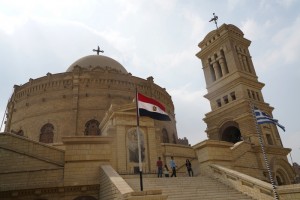 |
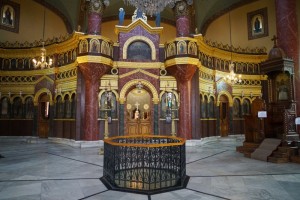 |
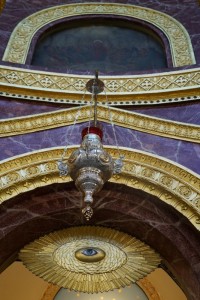 |
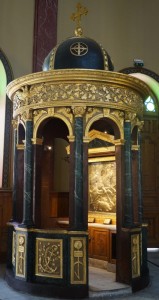 |
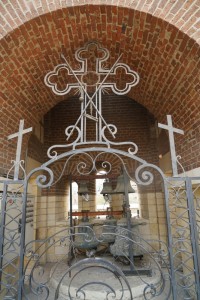 |
Then I wandered through the cemetery to reach the Abu Serga where the Holy Family once stayed.
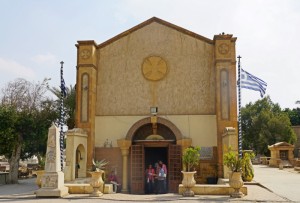 |
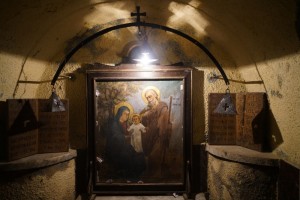 |
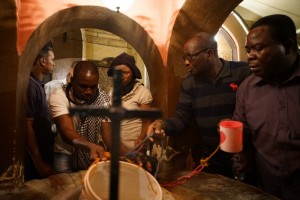 |
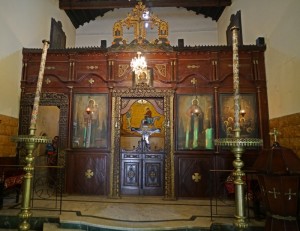 |
Before going to the Coptic Museum, I looked at the restored Babylon Fortress from the outside: it still looks impressive.
I spent the next two hours in the museum which exhibits are excellent with explanations in English. I begin to learn about the Monophysite Christians in the Coptic Church of Egypt, the Ethiopian Church, the Syrian Jacobite Church, the Syrian Church of India, and the Armenian Church – often called the Lesser Eastern Churches or the Oriental Orthodox Churches.
My final stop was the Hanging Church (also known as the Church of Virgin Mary) which is probably the oldest church in Egypt built in 4th century. The church (23.5m long, 18.5m wide and 9.5m high) built over two towers from Babylon fortress with logs of palm trees and a layer of stones over the fortress form the ground of the church. It was the seat of patriarch till 14th century. It’s more like a museum with 110 icons that go back to many centuries. The baptismal font goes back to the 5th century. The unique 11th century-pulpit rests on 15 marble columns.
I was unable to take photos as the battery was flat. It was hot and I was tired. So I returned to the hotel for a rest. On the way, I brought kofu (lamb) for lunch: E₤33 for four pieces, a salad and bread. Very cheap!
When I got up, the sun was setting. I therefore decided to walk to the river bank to watch sunset. I strolled along El Tahrir Street and but was too late for the sunset. I walked across the bridge and reached the Tahrir Square where the revolution that toppled Mubarak took place between January 25 and February 11, 2011, took place. Today, the skyline of Cairo next to the Nile is dominated by skyscrapers and 5-star hotels including the Intercontinental, Sofitel, Kempiski, Ritz-Carlton, Four Seasons, Sheraton, Novotel Hotels. I had to walk most carefully: the roads are not paved or uneven with many holes. There are few traffic lights and cars do not stop for pedestrians.
I walked back to the hotel and spent the evening uploading photos. The Wi-Fi was slow and broke off from time to time. I gave up and went to bed early .
October 21 Friday: Islamic Cairo
Islamic Cairo, also referred to as Medieval Cairo or Fatimid Cairo, was founded in 969 as the royal enclosure for the Fatimid caliphs. Overlooked by the Citadel, this part of Old Cairo has many historically important mosques and Islamic monuments.
After breakfast, I took a taxi (E₤30) to the Citadel. Built by Saladin El Ayouby (1137-1193), the Muslim Caliph that defeated the Crusaders and founder of the Ayyubid Dynasty who reigned from 1174 to 1193, the citadel was used as the seat of the ruler and his government in Egypt till Khediv Ismail moved his palace to the Abdeen Palace in 1860. Inside the citadel, there are three mosques (Mohammed Ali Mosque, El Nasser Mosque and Suleiman Pasha El Khadim Mosque) and three museums (National Military Museum, National Police Museum and Al Hawhara Palace Museum).
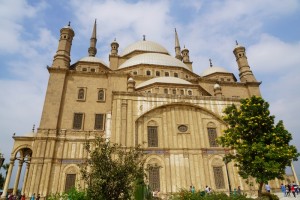 |
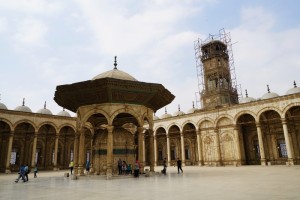 |
Built in memory of Tusun Pasha, Mohammed Ali’s oldest son who died in 1816, Mohammed Ali Mosque (1830-1848) is considered the best example of the Ottoman architecture in Egypt. I found myself surrounded by young school kids who wanted to take photos with me!
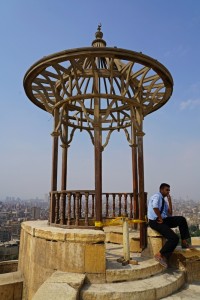 |
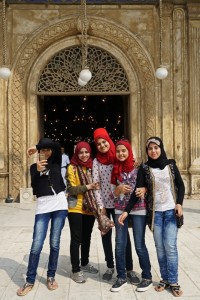 |
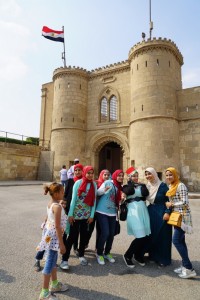 |
I spent almost two hours in the expansive citadel which affords fantastic panoramic views of the city, especially Old Cairo. I would like to visit the museums and the other two mosques. Unfortunately, they were all closed.
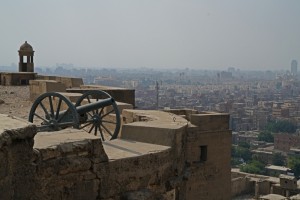 |
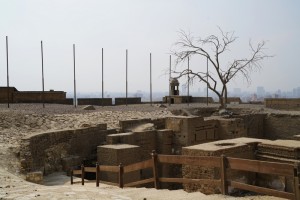 |
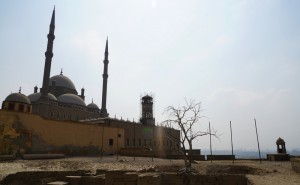 |
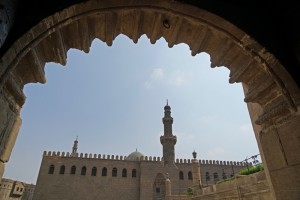 |
After the citadel, I planned to visit the nearby Sultan Hassan Mosque (completed in 1363) and Al-Rifa’i Mosque (built between 1869 and 1912). A local man asked me where I was going. I said, “ the two mosques. Old Cairo and Khan el-Khalili, a major souk in Old Cairo ” He said the two mosques would be closed till 5pm and suggested me follow him to the Aqsunqur Mosque (1347), one of the several “blue mosques” in the world. This man as expected asked me for money for his service!
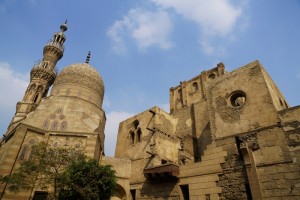 |
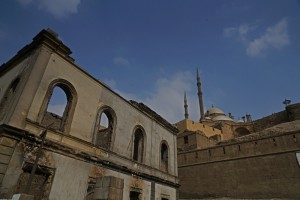 |
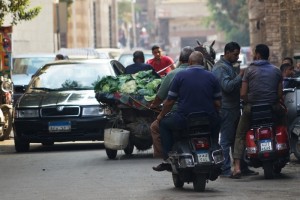 |
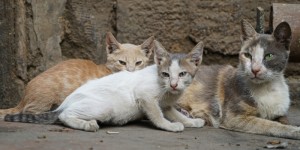 |
We followed the road Al Mahgar which leads to some of the oldest neighbourhoods in Old Cairo. This small blue mosque also serves as a funerary complex. The imam let me see the mausoleum of the founder of the mosque, Shams ad-Din Aqsunqur and open for me the door leading to the top of minaret. I found a few young men in the main praying hall and asked them for direction to the Khan el-Khalili. They said they would be going in the same direction and suggested me follow them. I did and had a wonderful time!
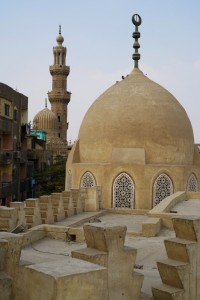 |
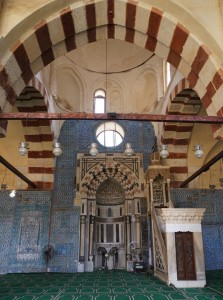 |
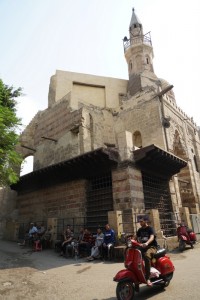 |
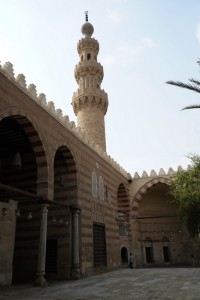 |
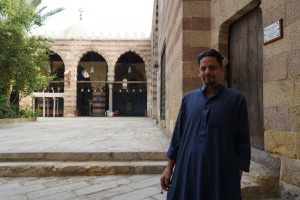 |
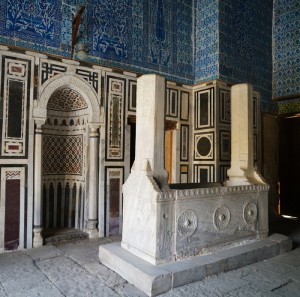 |
Ahmed, a student of philosophy in Cairo University was taking his friends to explore Old Cairo which has some of the oldest neighbourhoods and narrow streets have plenty of opulent town houses, mosques and madrassas built from the 10th century. We followed Al Mahgar and stopped at at a big but dilapidated mosque.
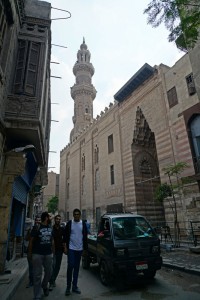 |
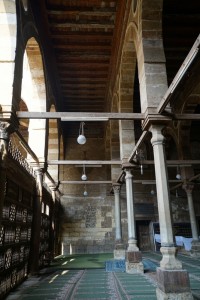 |
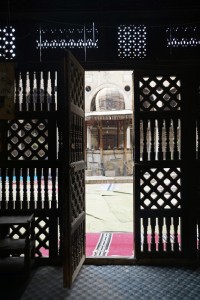 |
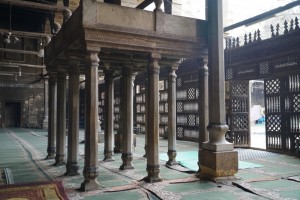 |
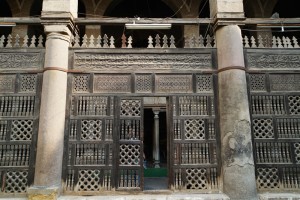 |
We followed the road Bab El-Wazir and visited a small old mosque located on the first floor.
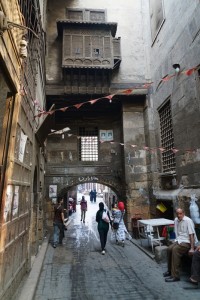 |
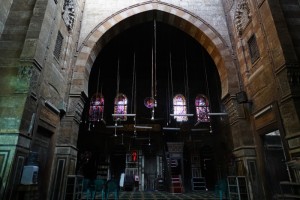 |
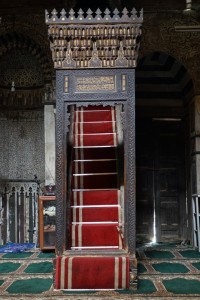 |
Then we arrived at the iconic twin-towered Bab Zuweila, one of the three remaining gates in the walls of Old Cairo and the last remaining gate of the Fatimid period (11th and 12th centuries). I joined my young friends and climbed a narrow staircase to reach the top of a minaret. The views of Old Cairo are fabulous!
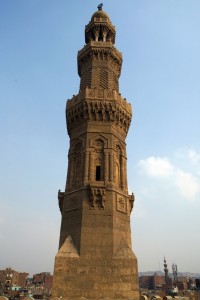 |
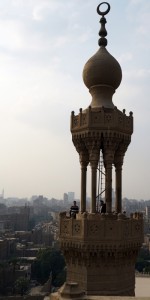 |
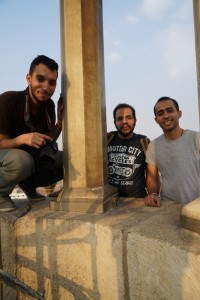 |
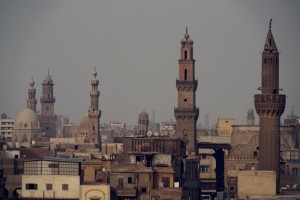 |
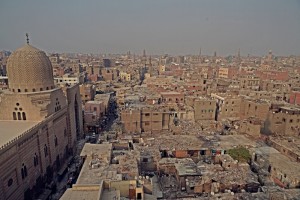 |
Next to Bab Zuweila is the Muayyed Mosque built on the site of a former dungeon where Sheik Amir Al Mu’ayyad was imprisoned. He built the mosque in 1415 when he became Sultan of Egypt. It was dark when we reached the mosque. While sitting in the praying hall, I asked my young friends about their views on politics and their future. They all have to serve the army for one to three years after university but do not like the idea at all. They follow the US Presidential election and have reservation on Donald Trump. They feel the society does not understand them and the future is uncertain. In their view, the present President is popular but the government is inefficient and the economy is not in a good shape. They are not optimistic about job opportunities.
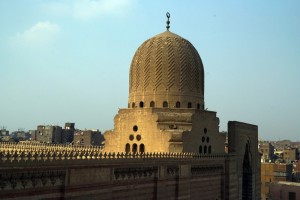 |
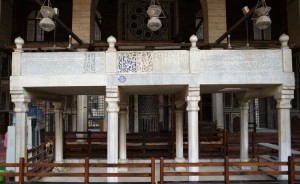 |
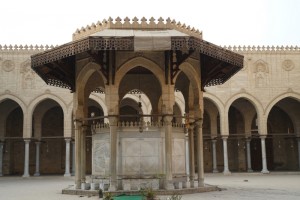 |
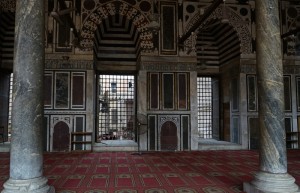 |
I was hungry as I had not eaten at all. I invited Ahmed and his friends to tea and dinner. Two had left and I went Ahmed and his two friends to a local eatery which was full. We had tea next door while waiting. The tea house owner was very kind and did not charge us. For dinner, I paid E₤90 for one piece of kofu and 250g of lamb chops. I wanted to pay for my friends but they insisted to pay their share.
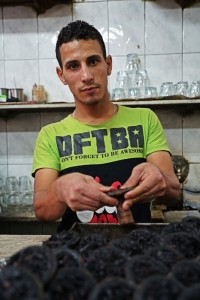 |
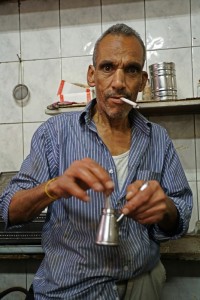 |
I find the old city more attractive and atmospheric in the evening: it looks more lively with the lights on and lots of local shoppers. We soon we reached the main road Nafak Al-Azhar where the Al-Hussein Mosque and the Al-Azhar Mosque are located. It was too late to visit these two important mosques and Khan el-Khalili. So we took a minibus to Al Shohadaa metro station which is next to the Ramses Train Station where I took the train to Luxor in 1979. I was back in the hotel after 8pm.
I was lucky to have met Ahmed and his friends who have given me a rare chance to learn about their thinking and to meet locals in the tea house. I am impressed by their generosity, honesty and hospitality. If Egypt has educated and promising young people like Ahmed and his friends, it will have a future.
Old Cairo is rich in history and studded with architectural gems and monuments. I had no time to see its major attractions including the Mosque of Ibn Tulun (the oldest and largest in Cairo), Al-Hussein Mosque, Al-Azhar Mosque and Khan el-Khalili etc. I shall return one day to spend more time in this unique city.


